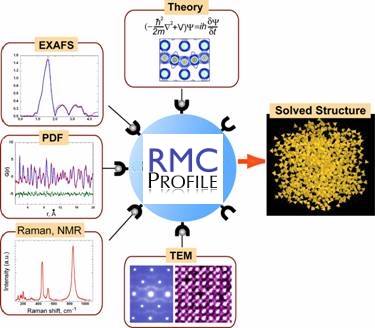Difference between revisions of "Main Page"
| (31 intermediate revisions by 2 users not shown) | |||
| Line 3: | Line 3: | ||
Welcome to the home of RMCProfile, here you can download the RMCProfile software, documentation and examples. | Welcome to the home of RMCProfile, here you can download the RMCProfile software, documentation and examples. | ||
| − | This version of RMC was built from the original RMCA code of McGreevy & Pusztai to determine the local structure of crystalline materials while still being capable of analyzing disordered systems. The current version of RMCProfile results from a collaboration between scientists at ISIS, University of Cambridge, University of Oxford & NIST[http://www.nist.gov/mml/ceramics/structure_determination/measurement-and-prediction.cfm]. It is now possible to fit many data types simultaneously (Neutron & X-ray total scattering & the Bragg profile, EXAFS, single crystal diffuse scattering) and use a range of constraints to produce atomic models that are consistent with all the available data. In this way we are progressing the effort to develop a 'complex modelling' approach to elucidate structural details of materials that are the key to their exploitable functional properties. | + | This version of RMC was built from the original RMCA code of McGreevy & Pusztai to determine the local structure of crystalline materials while still being capable of analyzing disordered systems. The current version of RMCProfile results from a collaboration between scientists at ISIS, SNS, University of Cambridge, University of Oxford, Queen Mary University of London & NIST[http://www.nist.gov/mml/ceramics/structure_determination/measurement-and-prediction.cfm]. It is now possible to fit many data types simultaneously (Neutron & X-ray total scattering & the Bragg profile, EXAFS, single crystal diffuse scattering) and use a range of constraints to produce atomic models that are consistent with all the available data. In this way we are progressing the effort to develop a 'complex modelling' approach to elucidate structural details of materials that are the key to their exploitable functional properties. |
| + | |||
| + | '''There is a now an additional RMCProfile website at ORNL. Please go [https://rmcprofile.pages.ornl.gov/ here]where you can access the most up to date information and also a new download page.''' | ||
| − | |||
{| | {| | ||
| Line 23: | Line 24: | ||
! width="20%" | | ! width="20%" | | ||
! width="40%" | [[Image:cam_logo.gif]] | ! width="40%" | [[Image:cam_logo.gif]] | ||
| − | | | + | | |
|- | |- | ||
| Line 29: | Line 30: | ||
! width="20%" | | ! width="20%" | | ||
! width="40%" | [[Image:NIST_Logo.gif]] | ! width="40%" | [[Image:NIST_Logo.gif]] | ||
| + | |- | ||
| + | |||
| + | |- | ||
| + | ! width="40%" | [[Image: ORNL_logo.png|250px]] | ||
| + | ! width="20%" | | ||
| + | ! width="40%" | | ||
|- | |- | ||
|} | |} | ||
| Line 37: | Line 44: | ||
| − | + | You no longer need to join the mailing list to download the software but you are still encourage to join it, please go [http://lists.rmcprofile.org/mailman/listinfo/rmcprofile-users here] to subscribe. If you had a wiki account, it will no longer work for the downloads, and you should have been automatically subscribed to the list (please check your spam/junk folders). (Please note this account is distinct from your RMC Forum [http://www.rmc-forum.org] account; should you have one you will still need to set up a separate RMCProfile mailing list account.) | |
| − | |||
| − | |||
| − | + | Unfortunately, it will not be possible to support users who are working with versions of the software that are not the current version. | |
| − | If you have problems accessing the site please email [mailto: | + | If you have problems accessing the site please email [mailto:tuckermg@ornl.gov;helen.playford@stfc.ac.uk us]. |
Latest revision as of 14:59, 31 May 2022
RMCProfile : Reverse Monte Carlo for crystalline and disordered materials
Welcome to the home of RMCProfile, here you can download the RMCProfile software, documentation and examples.
This version of RMC was built from the original RMCA code of McGreevy & Pusztai to determine the local structure of crystalline materials while still being capable of analyzing disordered systems. The current version of RMCProfile results from a collaboration between scientists at ISIS, SNS, University of Cambridge, University of Oxford, Queen Mary University of London & NIST[1]. It is now possible to fit many data types simultaneously (Neutron & X-ray total scattering & the Bragg profile, EXAFS, single crystal diffuse scattering) and use a range of constraints to produce atomic models that are consistent with all the available data. In this way we are progressing the effort to develop a 'complex modelling' approach to elucidate structural details of materials that are the key to their exploitable functional properties.
There is a now an additional RMCProfile website at ORNL. Please go herewhere you can access the most up to date information and also a new download page.
|
You no longer need to join the mailing list to download the software but you are still encourage to join it, please go here to subscribe. If you had a wiki account, it will no longer work for the downloads, and you should have been automatically subscribed to the list (please check your spam/junk folders). (Please note this account is distinct from your RMC Forum [2] account; should you have one you will still need to set up a separate RMCProfile mailing list account.)
Unfortunately, it will not be possible to support users who are working with versions of the software that are not the current version.
If you have problems accessing the site please email us.


